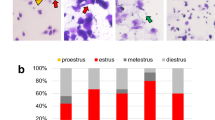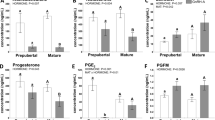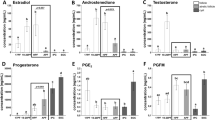Abstract
GONADOTROPHINS have been used for many years in laboratory work to induce ovulation in animals at specific convenient times1–5. An injection of pregnant mare serum (PMS) induces follicular growth, and if this is followed by an injection of human chorionic gonadotrophin (HCG) the mature follicles are ovulated at a predictable time. There are a few suggestions in the literature that this practice may lead to abnormalities in the offspring of the treated females6–8. In particular, Elbling8 reported that abnormalities in the digits and an altered sex ratio were found in litters born to gonadotrophin-treated female mice. As the practice of inducing ovulation by these means is widespread in research and is of practical importance in swine husbandry, we felt that this claim against PMS and HCG should be evaluated. We therefore repeated part of the experiment performed by Elbling8, with slight modifications, in that we did not study postnatal survival but observed digit normality, sex ratio and litter size in two stocks of mice in an effort to detect the influence that different genetic backgrounds may have in the response to exogenous gonadotrophins. We found no abnormalities in the digits or altered sex ratio in the offspring.
This is a preview of subscription content, access via your institution
Access options
Subscribe to this journal
Receive 51 print issues and online access
$199.00 per year
only $3.90 per issue
Buy this article
- Purchase on Springer Link
- Instant access to full article PDF
Prices may be subject to local taxes which are calculated during checkout
Similar content being viewed by others
References
Berger, M. J., Taymor, M. L., Karam, K., and Nudemberg, F., Fertil. Steril., 23, 783 (1972).
Day, B. N., Neill, J. B., Oxenrider, S. L., Waite, A. B., and Lasley, J. F., J. Anim. Sci., 24, 1075 (1965).
Leonard, S. L., and Smith, P. E., Proc. Soc. exp. Biol. Med., 31, 283 (1933).
Rowlands, I. W., J. Endocr., 3, 384 (1944).
Smith, P. E., and Engle, E. T., Am. J. Anat., 40, 159 (1927).
Boue, J. G., and Boue, A., Lancet, i, 679 (1973).
Chretin, F. C., Annls Endocr., 33, 507 (1972).
Elbling, L., Nature, 246, 37 (1973).
McLaren, A., and Michie, D., J. exp. Biol., 36, 281 (1959).
Butcher, R. L., and Fugo, N. W., Fertil. Steril., 18, 297 (1967).
Author information
Authors and Affiliations
Rights and permissions
About this article
Cite this article
SMITH, C., CHRISMAN, C. Failure of exogenous gonadotrophin controlled ovulation to cause digit abnormalities in mice. Nature 253, 631–632 (1975). https://doi.org/10.1038/253631a0
Received:
Published:
Issue Date:
DOI: https://doi.org/10.1038/253631a0
This article is cited by
Comments
By submitting a comment you agree to abide by our Terms and Community Guidelines. If you find something abusive or that does not comply with our terms or guidelines please flag it as inappropriate.



